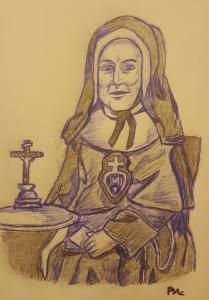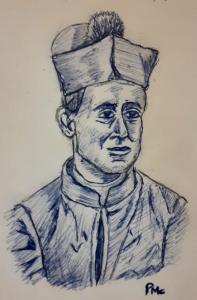 During the Industrial Revolution, Manchester became England’s leading manufacturing center. In 1844, Friedrich Engels, co-author of The Communist Manifesto, described it as “this hell upon earth.” One of its worst sections was Angel Meadow, which an 1848 observer called
During the Industrial Revolution, Manchester became England’s leading manufacturing center. In 1844, Friedrich Engels, co-author of The Communist Manifesto, described it as “this hell upon earth.” One of its worst sections was Angel Meadow, which an 1848 observer called
the lowest,most filthy, most unhealthy and most wicked locality in Manchester… the home of prostitutes, their bullies, thieves, codgers, vagrants, tramps, and in the very worst sties of filth and darkness… the low Irish.
About this time, a young woman named Elizabeth Prout (1820-1864) began ministering there. For the next fifteen years until her death, she taught children, visited the sick, and ran homes for “factory girls.” In time, she formed a religious community now known as the Passionist Sisters. Presently on the road to canonization, Elizabeth has been called “a Victorian Mother Teresa.”
Raised an Anglican, Elizabeth’s peers described her as “refined, intelligent, and gently nurtured.” In her early twenties, she became interested in Catholicism through a Passionist priest, Blessed Dominic Barberi, who started a monastery near her home. Much to her parents’ chagrin, Elizabeth converted to Catholicism after hearing Dominic preach on the Eucharist.
In 1848, she joined the Sisters of the Infant Jesus, but had to leave when diagnosed with tuberculosis. Back at home, her mother’s hostility forced her to, biographer Sister Edna Hamer writes, “choose between her Catholicism and her home. She chose her Catholicism.” In 1849, Elizabeth started teaching in Manchester as a layperson.
Soon she gathered a group of like-minded women around her. They taught children and tried to bring their families to Mass, Hamer notes, in “a locality noted for wickedness and crime.” Elizabeth’ spiritual adviser, the Passionist Gaudentius Rossi, suggested she start a new order. In November 1852, taking the name Mother Mary Joseph of Jesus, she and her companions assembled as the Institute of the Holy Family.
At that time most communities required a dowry to join, but Elizabeth didn’t. This was a community for working-class women, who at the time were not considered respectable enough for the convent. The Sisters supported themselves through teaching, with needlework, even by working in the cotton mills. They started homes for women who worked in the factories. One priest observed that they endured “extreme poverty, obloquy, ridicule and scorn.”
It was tough. By 1857, there were some twenty of them, living in extreme poverty. Their school had no supplies, blackboards, or even desks. Anti-Catholicism was strong; convents were called “Romish dens of impurity and female degradation.” Ex-Sisters maligned the community, which led to an investigation by Church authorities (the Sisters were ultimately exonerated.) Still, Hamer writes, Prout guided the young community through hard times by her business acumen as well as her cheerfulness on all occasions.
Through their work, they saved many young women from a “life of degradation and peril” through the homes they ran. Female residents worked at their jobs during the day; at night they had classes in reading, writing and home-keeping. One priest observer commented: “I found these poor factory girls well instructed and extremely good.”
Through her relationship with Fathers Barberi and Rossi, she was very close with the Passionists. (Rossi was largely responsible for her community rule, which was based on the Passionist model.) Eventually the Sisters formally aligned themselves with the Passionists. This helped put Elizabeth’s mind at ease regarding the future of her community.
In the winter of 1863-1864, she caught a cold which aggravated her tubercular condition. She died on January 11. When he heard the news, the The local bishop commented: “Well, she did a good thing in her life.” Elizabeth’s canonization cause was opened in 1994. Hamer describes her as
A working-class woman who, in an unusual way, was committed to changing the world in which she lived and worked… Her aim was a radical identification with Christ in His Passion, partly through a life of personal austerity and partly through a commitment to serve Him in the poor.
Servant of God Elizabeth Prout, pray for us!
(*The drawing of Mother Prout is by Pat McNamara.)











